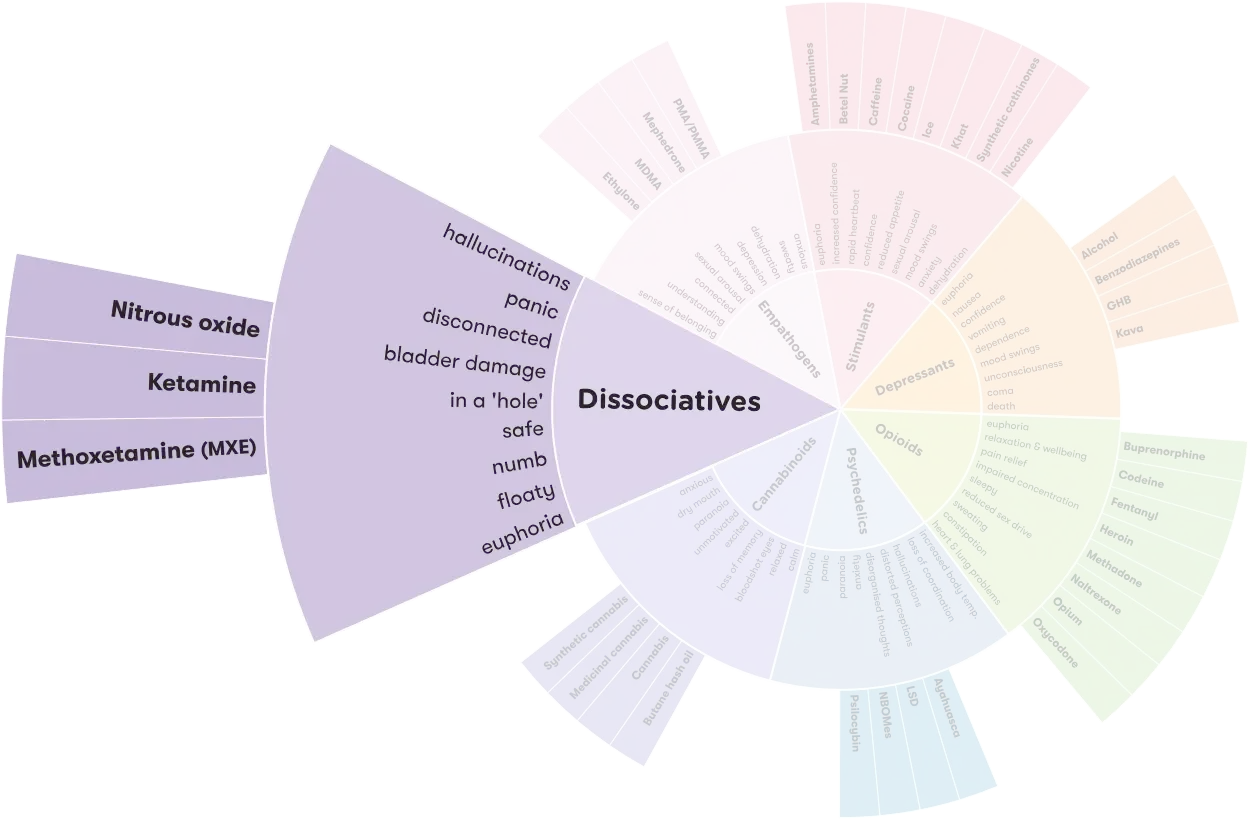Dissociatives
Last published: March 07, 2025
What are dissociatives?
Dissociatives (also referred to as 'dissociative anaesthetics') are a class of psychedelic drug. This class of drug causes people to feel separated or detached from their body or physical environment.
Dissociatives can also cause hallucinations and other changes in thoughts, emotions and consciousness.1
Examples of dissociatives
- Ketamine – dissociative anaesthetic that is used in surgery and veterinary medicine. It causes amnesia (memory loss) and analgesia (pain-relief). Low doses produce stimulant effects; medium to high doses produce possible out-of-body or near death experiences.2
- PCP – Phencyclidine (PCP) is a drug that has both hallucinogenic and dissociative properties. The dissociative effects of PCP leaves users feeling removed from their body and their environment. This effect produces a trance-like state. It also has strong anaesthetic effects, which produces amnesia (memory loss) and analgesia (pain-relief). Also known as “angel dust”.2
- DXM – (lean, dank) Dextromethorphan is a medication usually used as a cough suppressant in cold and cough medicines. It is sold in syrup, tablet, spray, and lozenge forms.4
- Nitrous Oxide – (nangs) Nitrous oxide is a dissociative anaesthetic and has been found to produce dissociation of the mind from the body (a sense of floating), distorted perceptions and in rare cases, visual hallucination.3
- Methoxetamine is derived from ketamine and also has dissociative properties. It lasts longer and has more powerful effects than ketamine, but lower analgesic and aesthetic effects. The main effects include hallucinations, depersonalisation and dissociation.4
What do dissociatives look like?
Dissociatives can be in the form of pills, powders, gases, liquids and plants.
How are they used?
Dissociatives are usually ingested via snorting, oral, intramuscular injection or inhaled.
Commonly used dissociatives
Explore dissociatives on the Drug Wheel

Effects of dissociatives
Use of any drug can have risks. It’s important to be careful when taking any type of drug.
Dissociatives affect everyone differently, based on:
- size, weight and health
- whether the person is used to taking it
- whether other drugs are taken around the same time
- the amount taken
- the strength of the drug (varies from batch to batch)
- the environment (in which the drug is taken).
The individual effects and toxicity of each dissociative can vary greatly between each person using them.
Many dissociatives have general depressant effects including drowsiness, slow ineffective breathing, pain relief, anesthesia, and loss of muscle control, as well as cognitive and memory impairment.
Amnesia is an often-reported side effect. Some dissociatives affect dopamine release and the opioid systems of the body and may produce euphoria.5
The effects of dissociatives can vary but generally speaking they are short acting, depending on the specific type of dissociative. The following may be experienced during this time:
- euphoric
- floaty
- relaxed
- happy
- pain-free
- numb
- protected
- safe
- unconscious
- unaware
- in a ‘hole’
You might also become unconscious or experience visual or auditory hallucinations (seeing or hearing things that aren’t there or are distorted).
Long-term effects
Large regular doses of ketamine can cause ‘ketamine bladder syndrome’, a painful condition that requires ongoing treatment. Symptoms include difficulty holding urine and incontinence, which can cause ulceration in the bladder.
It’s important that if you’re suffering from ketamine bladder syndrome you stop using the drug and see a health professional immediately.7, 8
Inhaling nitrous oxide (nangs) is considered to be relatively harmless. But, regular long-term use can cause vitamin B12 deficiency, which can lead to nerve damage and some types of anaemia.8
Impact of mood and environment
Drugs that affect a person’s mental state (psychoactive drugs) can also have different effects depending on a person’s mood (often called the ‘set’) or the environment they are in (the ‘setting’).
Set: a person’s state of mind, previous encounters with dissociative drugs, and expectations of what’s going to happen. For example, feelings of stress or anxiety before using dissociatives may result in an unpleasant experience.9
Setting: the environment in which someone consumes dissociatives – whether it’s known and familiar, who they’re with, if they’re indoors or outdoors, the type of music and light. For example, using dissociatives in a calm, quiet and relaxed environment can lead to, or contribute to, a pleasant experience but being in a noisy, crowded place may result in a negative experience.9
Being in a good state of mind, with trusted friends and a safe environment, before taking dissociatives reduces the risk of having a negative experience.
Reducing harm
Use of dissociatives is likely to be more dangerous when:
- taken in combination with alcohol or other drugs, in particular benzodiazepines and opiates as these can slow breathing and increase the risk of overdose
- driving or operating machinery, as a person’s ability to judge distance and space is extremely limited
- used in unsafe environments such as nightclubs or festivals. There have been several reports of people hurting themselves whilst impaired and attempting to move around
- used in large doses or repeatedly. Dissociatives may be neurotoxic, meaning toxic to the nervous system
- alone (in case medical assistance is required)
- the person has a mental health problem.10
You might feel nauseous on many dissociatives, usually directly after dosing and often only when you have something in your stomach. It is best to not eat for 3-4 hours before dosing.10
Dependence and tolerance
There’s evidence to suggest that people who use dissociatives can develop dependence (addiction) and tolerance to them. Tolerance means you need to take larger amounts to get the same effect.
Tolerance to dissociatives develops with repeated, prolonged use. This results in having to take increasing larger doses to achieve the same effect. It can take around 2 weeks for tolerance to be back at zero.10
Dependence on dissociatives can be psychological, physical, or both.
People who are dependent on dissociatives may find that using them becomes far more important than other activities in their life. This might include craving dissociatives and finding it very difficult to stop using them.
Physical dependence occurs when a person’s body adapts to the dissociatives and gets used to functioning with the drugs in their system.
Psychologically dependence might include someone feeling an urge to use it when they are in specific surroundings or socialising with friends.
More on Polydrug use
Polydrug use is a term for the use of more than one drug or type of drug at the same time or one after another. Polydrug use can involve both illicit drugs and legal substances, such as alcohol and medications.
Getting help
If your use of dissociatives is affecting your health, family, relationships, work, school, financial or other life situations, or you’re concerned about someone else, you can find help and support.
Call the National Alcohol and Other Drug Hotline on 1800 250 015 for free and confidential advice, information and counselling about alcohol and other drugs
Help and Support Services search
Find a service in your local area from our list. Simply add your location or postcode and filter by service type to quickly discover help near you.
If you're looking for other information or support options, send us an email at druginfo@adf.org.au
Path2Help
Not sure what you are looking for?
Try our intuitive Path2Help tool and be matched with support information and services tailored to you.

- Li L, Vlisides P. Ketamine: 50 Years of Modulating the Mind. Frontiers in Human Neuroscience. 2016;10:1-15.
- Williams A. Drug Abuse Sourcebook. Detroit: Omnigraphics, Inc 2019 [cited: 31.03.2022].
- Brands B Sproule B Marshman J. Drugs & Drug Abuse. 3rd ed. Ontario: Addiction Research Foundation; 1998.
- World Health Organization. Methoxetamine (MXE) Critical Review Report. 2015.
- National Institute of Drug Abuse. What Are the Effects of Common Dissociative Drugs on the Brain and Body? ; 2015.
- Orhurhu V Vashisht R Claus L Cohen S. Ketamine Toxicity. 2022.
- National Drug and Alcohol Research Centre. Ketamine What you need to know 2014 04.04.2022].
- Morgan C Curran H. Ketamine use: a review. Addiction 2011;107(1).
- Nutt D. Drugs without the hot air : making sense of legal and illegal drugs. Cambridge: UIT Cambridge Ltd; 2012.
- Giné C Calderón F Guerrero J. Patterns of use, harm reduction strategies, and their relation to risk behavior and harm in recreational ketamine users. The American Journal of Drug and Alcohol Abuse. 2015;42(3).
